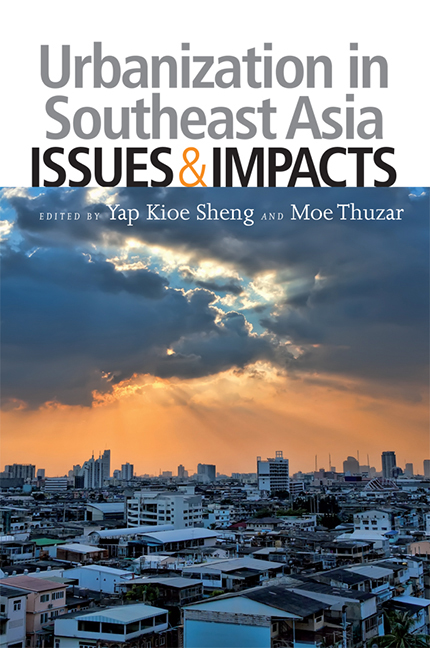Book contents
- Frontmatter
- Contents
- Message from Head, ASEAN Studies Centre
- Message from Director, Centre for Liveable Cities
- About the Contributors
- Introduction
- Urbanization in Southeast Asian Countries: Recommendations
- 1 The Challenges of Promoting Productive, Inclusive and Sustainable Urbanization
- Cities as Engines of Development
- Inclusive Cities
- 6 Addressing Urban Poverty in ASEAN: Diversity of Conditions and Responses, Unity of Purpose
- 7 The HDB Community: A Work in Progress
- 8 Rural-Urban and Intra-Urban Linkages in Southeast Asia: Old Field, New Dynamics
- Cities and the Environment
- Governance, Decentralization, and Urbanization
- Urbanization from an ASEAN Perspective
- Index
6 - Addressing Urban Poverty in ASEAN: Diversity of Conditions and Responses, Unity of Purpose
from Inclusive Cities
Published online by Cambridge University Press: 21 October 2015
- Frontmatter
- Contents
- Message from Head, ASEAN Studies Centre
- Message from Director, Centre for Liveable Cities
- About the Contributors
- Introduction
- Urbanization in Southeast Asian Countries: Recommendations
- 1 The Challenges of Promoting Productive, Inclusive and Sustainable Urbanization
- Cities as Engines of Development
- Inclusive Cities
- 6 Addressing Urban Poverty in ASEAN: Diversity of Conditions and Responses, Unity of Purpose
- 7 The HDB Community: A Work in Progress
- 8 Rural-Urban and Intra-Urban Linkages in Southeast Asia: Old Field, New Dynamics
- Cities and the Environment
- Governance, Decentralization, and Urbanization
- Urbanization from an ASEAN Perspective
- Index
Summary
URBANIZATION AND POVERTY IN ASEAN
The steady urbanization of Southeast Asian nations is generally viewed as a positive development in the economic history of the region. Cities are recognized as epicentres of economic growth and contribute significantly to national incomes. Because of their ability to earn more in absolute terms, urban populations are generally perceived to be better off than their rural counterparts.
All over Asia, poverty incidence is still much higher in rural areas than in urban areas. National governments will therefore tend to address rural poverty in national policy and plans, given resource limitations. It is often said that although poverty seems more visible and geographically concentrated in cities, the poor who choose to stay in urban areas are much better off than their rural counterparts. Despite having very low cash incomes, the poor in urban areas are expected to have, at the very least, more access to social services in the cities.
Because poverty has often been associated with rural areas in Southeast Asia, urban poverty issues have largely been relegated to the background in the regional policy discourse. Regional level efforts that deal with economic development as a means to address poverty often focus on investments in infrastructure and agricultural productivity in rural areas. Urban development is then largely left to market forces or private sector decisions. Moreover, rural poverty is seen as more urgent and compelling and therefore more resources and time are poured into addressing it.
However, with the rise of urban populations and, with it, an increase of urban poverty incidence, addressing urban poverty issues alongside rural poverty issues may no longer be delayed. An estimated 41.8 per cent of Southeast Asia's total population or, almost 245 million people, live in urban areas. In 1950 the urban population represented only 15.4 per cent of the total population. By 2025, the urban population of the region is expected to increase to 49.7 per cent of the total population (Yap 2010).
The rise of urban populations is expected to put pressure on the existing infrastructure and social services in cities. The informality of infrastructure and services provision in cities, as evidenced by informal settlements in rapidly expanding urban centres, is a concern of national governments. Civil society organizations and community-based non-government organizations regard informal settlements as solutions rather than problems.
- Type
- Chapter
- Information
- Urbanization in Southeast AsiaIssues and Impacts, pp. 175 - 189Publisher: ISEAS–Yusof Ishak InstitutePrint publication year: 2012



